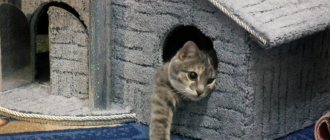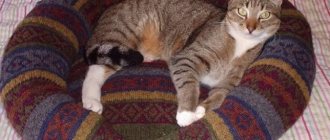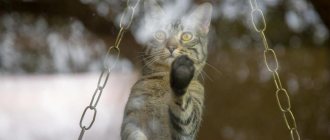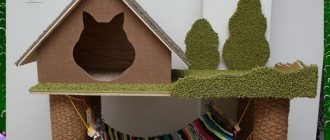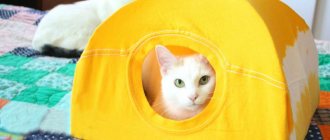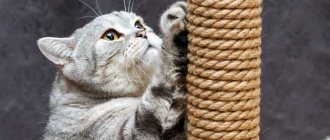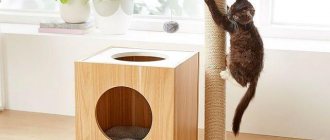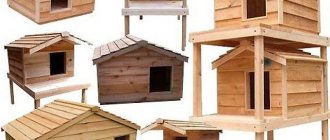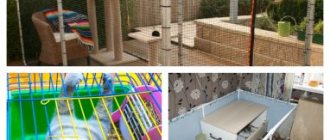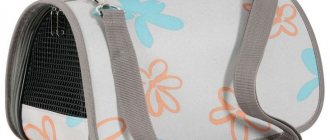When a pet appears in the house, and even one as cute as a cat, it becomes more comfortable and warm, cozy. Why does a furry pet need its own personal hole, since it has all the space in the apartment at its disposal? Fluffy feels comfortable on your pillow or in your bed, on an armchair or even in your closet. But this cannot replace a personal home for a pet.
And besides, a beautiful, homemade cat house knitted, crocheted or made from any other materials will be an effective addition to the interior, giving it special charm and harmony.
Maybe buy a cat house? Online stores and specialized boutiques offer a wide range of cozy, comfortable homes for pets. But making a cat house with your own hands has its advantages.
Firstly, it is economical. To knit an aesthetic product, you will need yarn, knitting needles or a hook, a pattern and a little imagination. Secondly, it will fully match the size of your pet and will fit beautifully into the interior of the room.
Which yarn to choose: pros and cons of each type
For a cat to like its new home, it must be comfortable for the pet. Much depends on the material. You need to choose yarn based on the needs of the animal, not the owner.
Wool
Wool is a good option for a winter home. It retains heat well and does not allow moisture to pass through. The woolen house will not lose its shape after several washes, and cat claws will not ruin it immediately.
Among the disadvantages: pellets may form on the product, and if the yarn is of low quality, then the cat’s home will turn out to be prickly. The first problem can be solved by careful care and dry cleaning, the second by choosing high-quality material. There are allergies to wool - not only in people, but also in cats; this fact cannot always be identified in advance.
Acrylic
Acrylic is cheaper than wool, and there are practically no allergies to it in either people or cats. It is durable, the resulting products are easy to care for, and a variety of colors will help make the cat’s house a stylish piece of art.
But there are disadvantages - acrylic does not allow air and moisture to pass through well. If the acrylic house is not washed often enough, the cat's hair may begin to fall out. To solve this problem, you need to use additional bedding inside the product. Another trouble is static. It is unlikely that a cat will want to climb into a house where discharges crackle from every movement. The animal may find the smell of antistatic agent too strong.
Viscose
Viscose allows moisture to pass through well, does not electrify, is available in a variety of colors, and retains heat. She is very soft. But this type of yarn is not without its drawbacks - viscose is demanding to care for, and if washed incorrectly, it quickly loses its appearance and shape.
To combine the advantages and compensate for the disadvantages of each type, combined threads are used - wool/viscose or acrylic/viscose.
Beds in the form of animals
The description for this cat is paid. To watch, follow the link.
Here's another super idea:
https://pin.it/fbiu24aeajx3rr
Which knitting method is suitable
The most convenient way to crochet a house is to get the desired shape easier. But if the housewife likes to knit, this is also doable.
Short Crochet
The main technique that is suitable for a cat house is short crochet. The loops and posts are successively strung on top of each other, gradually creating the product. It takes patience and perseverance, but the results are worth it.
Tunisian knitting
Tunisian knitting is suitable if you need to make a large house for a Maine Coon or a cat that likes to stretch out its paws in its sleep. A long hook is used, on which loops are cast on, like on a knitting needle.
Circular knitting
Circular knitting is suitable for quickly making beds with low sides. The fabric is supported by four knitting needles, the fifth is used as a working knitting needle. The method is not suitable for complex structures.
Instructions for crocheting a cave house
In order to make a cat house, you will need:
- two hooks (No. 8 and 10);
- tapestry needle;
- stitch markers (you can work without them, but it’s inconvenient).
Dimensions of the finished product: diameter of the bottom and roof - 38 cm, height of the walls - 18 cm. It will require 400g of acrylic/viscose. The main method of knitting is double crochet and single crochet.
Making the bottom
The bottom determines the size of the finished cat house. For knitting you will need a No. 8 hook. Process steps:
- Knit 4 air loops, close into a ring.
- The first ring is 3 chain stitches, then 11 double crochets, the last stitch is connecting to the first loop.
- The second ring also starts with 3 chain loops, then alternating - 1 double crochet in the last loop of the previous ring, then double crochet in each loop of the row (24 in total).
- Each subsequent ring begins with 3 air loops. They are followed by double crochets, their number increases by 12. The last stitch is the connecting stitch with the last of the loops. There are 96 columns in the eighth circular row.
- The ninth row ends with a connection not with the last, but with the first loop of 3 air loops at the beginning of the row.
This creates a round base for the house. The mating density will not be too tight, but this is normal - the cat will not have to sleep in this house on the street.
Side walls
To continue, you need to replace the hook and take a second thread. In order for the walls of the house to acquire a vertical shape, the number of columns must be constantly reduced. The beginning of a new stage of work should be marked with a marker - this will make it more convenient to work. Now you need to use single crochets. Sequencing:
- In the first circular row, every fifth column is connected to 2 loops. There are 90 of them in total.
- The next two rows repeat the first, only without decreasing.
- The fourth row, which is also the first for the entrance, begins with an air loop, then 79 single crochets are knitted.
- The knitting needs to be turned over and the previous row repeated in the opposite direction. There are 8 such rows in total.
- In the ninth row, one additional column appears - at the beginning and at the end (82 columns).
- At 10–84 stitches, it repeats the previous row.
- The next row is 6 chain stitches, the last one is connected to the loop on the other side of the hole. Then repeat the base of the wall - 90 single crochets.
This creates a round wall with an opening for entry.
Completion - roof
The end of the walls and the beginning of the roof should be marked with a marker. Then the second thread is disconnected, leaving only the first, the hook must be changed again. As for the bottom, double crochets are used. Sequence of work:
- Three chain stitches, 90 double crochets, the last one connecting with the third loop from the beginning of the row.
- Three chain stitches, then double crochets. Every tenth time two loops are knitted (80 stitches).
- Then each row the number of columns is reduced by 10.
- The last row is to knit two loops together and make a connecting stitch.
The remaining thread needs to be cut, leave a long piece, and use it to tighten the loops so that the product becomes evenly tight. The entrance must be tied with the same thread, using a “crawfish step”. If desired, the finished house can be decorated with decorative details.
Crochet pattern
A cat house is crocheted quite quickly and easily if you are at least a little familiar with this technique. Let's start from the bottom. To perform it, we use hook No. 8. Cast on 3 air loops (hereinafter ch), close the chain into a ring using 1 connecting post (hereinafter ss). The rows will begin with one ch rise and end with a ss.
- 8 single crochets (hereinafter sc), close in a circle;
- increase x8 (16);
- (sc, inc) x8 (24);
- (2sc, inc) x8 (32);
- 32 single crochets;
- (2 sc, inc) x8 (42);
- 42 single crochets;
- (2 sc, inc) follow the sequence until the end of the tier (56);
- 56 single crochets;
- (2sc, inc) we follow the sequence until the end of the tier;
- single crochet in each loop of the previous tier;
- (4 sc, inc) repeats until the end of the tier;
- 13-16. single crochet in each loop of the previous tier;
- (5 sc, inc) and so on until the end of the row;
- single crochet in each loop of the previous tier.
Now you need to make a kind of entrance to the home. To do this, you need to knit half a row of sc in each loop, cut the thread, leave the end (this is the 19th row). Then we perform one sc in each loop, when only 5 remain, we tie in the tail remaining from the previous row and break the thread.
Next, 10 single crochets - skip, we start knitting from the place where the previous row began, we knit the remaining ends of the threads into the main fabric to give the product an aesthetic appearance (20 row). We repeat the 20th row five more times (21-25 rows). The entrance to the house is knitted in 7 circles.
When doing the work, you need to make sure that the lines are perfectly even and neat; you should start and finish knitting in the same column. Next, we carry out the work according to the scheme:
- 26th row we knit sc in each loop (hereinafter kp.) of the previous row, we close the row after knitting 8 loops above the entrance;
- 27-30. sc in k, repeat until the circle is completed;
- (4 sc, dec) repeat until the end of the tier;
- 32-33. sc in k, repeat until the end of the row;
- (3 sc, dec) repeat until the end of the tier;
- sc in kp, repeat until the end of the tier;
- 36-37. (3 sc, dec) repeat until the end of the tier;
- 38-39. (2 sc, dec) repeat until the circle is completed;
- 40-41. (sc, dec) and so on until the end of the tier.
The ring should close. If this does not happen, we continue to knit tiers with decreases. We carefully hide the remaining ends of the thread in the fabric so that they do not stick out and spoil the appearance of the product.
If you have experience and skills in this technique, you can additionally knit cat ears or perform any other decorative elements. Here, in fact, the personal space for the pet is ready. You can lay something soft inside and put the house into operation.
You need to crochet a cat house strictly according to the pattern. Any mistake, even one missed loop or stitch, can have a bad effect on the aesthetic characteristics of the product. Such housing for a pet is not only beautiful, but also cozy. There the fluffy will feel protected and comfortable.
A homemade cat house will harmoniously complement the interior if you choose the right yarn color and also use a creative approach to its design.
Cats love hiding places, but finding them in an apartment is difficult. Cat houses help create comfortable conditions for your pet. They are sold in pet stores and pet supply departments. But if none of the ready-made options suits you, you can make a knitted cat house with your own hands. The pet will feel comfortable in it, and the owner will be able to enjoy communication with a happy and calm animal.
Types of knitted houses with photos
There are many types of pet housing. The main distinguishing parameter is the shape of the house. The photo shows the most common options:
- Round knitted house (nest);
- House-bed;
- Pipe house;
- Soft Cave House;
- Bed with low sides.
Video: Instructions for crocheting a basket for a cat
A cat house is a useful thing that makes it possible to make your pet’s living environment as comfortable as possible. If you have time, materials and imagination, then it will be easy to incorporate cat’s joys into the interior of the room.
Simple but cozy house
There is even a free description of this house, but it is in English. Write to me in the comments below the post if you need a translation. I will then translate and publish in a separate post. ( Added: translation done! Link to description:
Crocheted cat house from knitted yarn ).
DIY knitted cat house
When a pet appears in the house, and even one as cute as a cat, it becomes more comfortable and warm, cozy. Why does a furry pet need its own personal hole, since it has all the space in the apartment at its disposal? Fluffy feels comfortable on your pillow or in your bed, on an armchair or even in your closet. But this cannot replace a personal home for a pet.
And besides, a beautiful, homemade cat house knitted, crocheted or made from any other materials will be an effective addition to the interior, giving it special charm and harmony.
Maybe buy a cat house? Online stores and specialized boutiques offer a wide range of cozy, comfortable homes for pets. But making a cat house with your own hands has its advantages.
Firstly, it is economical. To knit an aesthetic product, you will need yarn, knitting needles or a hook, a pattern and a little imagination. Secondly, it will fully match the size of your pet and will fit beautifully into the interior of the room.
Cardboard house
The main advantage of a cardboard house is the variety of models. Cardboard houses are assembled in the form of a birdhouse, castle, tent, cave. And that is not all…
It is possible to assemble a cardboard house yourself. On the Internet you can find sample templates that will help you get the job done right. But do not forget that a house made of such material is not durable. Having played out, the pet can easily destroy its building. Owners should not be upset. You can always make a new “fortress”.
How to knit a cat house
The most popular option for knitted houses for pets is an igloo (a form of Eskimo housing). If you complete all the steps correctly, you will get a fairly compact, comfortable, aesthetic product that will not only become a cozy home for your pet, but will also harmoniously complement the interior.
Below are instructions on how to connect a house with the following parameters:
- round shape with a hole on the side wall, which serves as an entrance;
- bottom diameter - 37 cm;
- the height of the structure is 20 cm.
For production you will need high-quality, durable yarn. It's best to buy a ball at the store, but you can use thread that was left over from an old sweater or some other unnecessary thing. Tools you need to stock up on include stitch markers, tapestry thread and hooks.
Large baskets
By the way, this is a worthy use for super thick yarn! I think one skein is enough.
https://pin.it/ywcwqapjkkqzvk
https://pin.it/sp5bqin7m3vdo5
